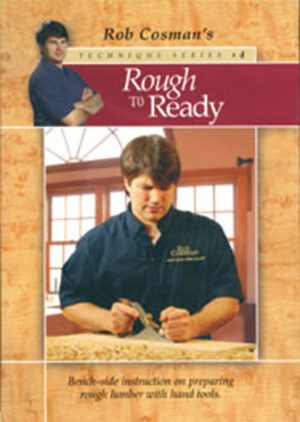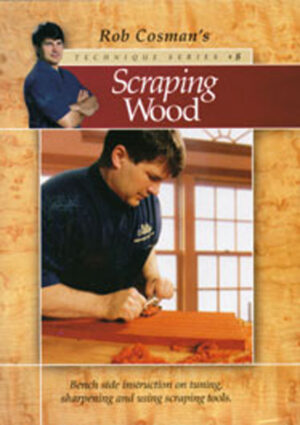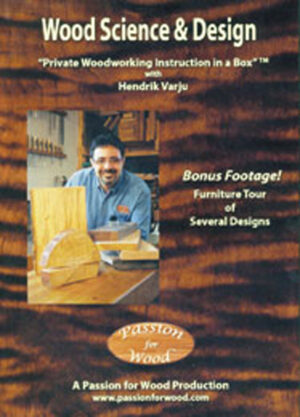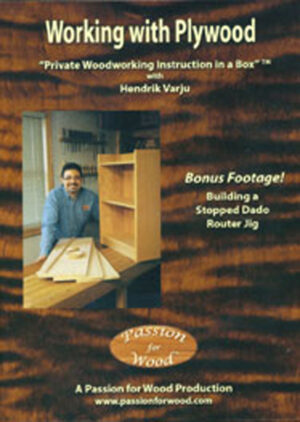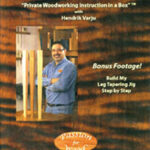MAKING TAPERED TABLE LEGS DVD
$110.00
Private Woodworking Instruction in a Box
with Hendrik Varju
Produced by Passion for Wood, Ontario, Canada
ISBN 978-0-9881280-8-8
As reviewed in The Australian Woodworker Issue 191
This is the latest set of DVDs in Hendrik Varju’s Series: Private Woodworking Instruction in a Box. The presentation occupies four disks which have a total running time of eight hours. Those who are unfamiliar with Varju’s meticulous approach to the craft may be forgiven for thinking that this seems overly long for a discussion about Tapered Legs.
As usual, however, the videos cover a great deal more than just the nominated subject. In fact, it is perhaps fortunate that making tapered legs requires so many different functions, since each necessitates the discussion of many other topics. For example, the viewer is given short, intense, overviews of information related to design, wood science, planing, thicknessing, gluing-up, routing and sanding.
Disk 1 starts with a quick discussion about the types of tapered legs – tapered on the inside, tapered on the outside, tapered all round, tapered only at the bottom…
The next topic considered is the making of legs from two or more pieces of wood. This raises a number of potential problems. The author shows why it is necessary to become adept in reading the grain of the wood if these are to be satisfactorily overcome.
The grain patterns are used to determine the way in which the pieces are mated so as to minimise the chance of cracking either immediately or at some time in the future.
Grain is also important in determining how the wood is presented to the Planer and Thicknesser. (Varju mostly uses the American convention of calling these a Jointer and Planer, though he occasionally refers to the latter as a Thicknesser. There is no chance of viewers being confused, however, since the operations on the machines are performed on camera.)
Optimum results are assured by first assessing the grain characteristics of the wood and then using marks to guide its milling.
Finally, the grain that is exposed down the sides of a leg has to be taken into account in order to achieve the desired appearance.
Two pieces of Oak are used to demonstrate the making of a composite leg. Once they have been cleanly milled to the exact size required, they are ready for gluing. Varju has a host of comments here – from why it is desirable to keep the pieces overlength during this part of their preparation, to how many clamps should be used, where they should be placed and what area of effect each one of them may be expected to have.
He explains why the leg blanks should again be milled (though very lightly) after any glue residue is removed.
The operations that follow include cutting the legs to their finished length, cutting the joints that will secure them to the rest of the structure and adding any decorative features that have been planned.
Two types of joint are demonstrated in detail – a 3-dowel joint using a proprietary dowelling jig and a mortise and tenon joint using a chisel mortise kit in a drill press.
Chamfers are added at the top of the outside edge of the leg and also where it attaches to the apron, while three equi-spaced flutes are cut on the exposed faces between them. Both are cut on a router table and again, they are described and demonstrated in detail.
Remembering the earlier remark about the length of discussion of this topic, it is relevant to note that it is not until Disk 3 of the set, that the actual tapering of the legs is undertaken. But Varju’s treatment of the subject offers ample proof that this preparatory work is essential to achieving the best possible results as well as exploring the most important options.
The legs are tapered on a tablesaw using a special jig which Hendrik Varju made to his own design. It is a simple arrangement but it will suit the making of legs in all of the common lengths – from short legs for coffee tables through to legs long enough for a table or desk.
Once the tapers are cut, the legs are returned to the planer after which they are sanded. The guidance on sanding that is given at this point includes a discussion of the grits most suitable and the suggested durations for each stage in the sanding operation.
Although Varju prefers to cut tapers on a tablesaw, he remarks that it is sometimes necessary to make them on a bandsaw. It is a preference based principally on the difference in the quality of the cut surface – the tablesaw cut requiring considerably less planing and/or sanding.
For those occasions when it may be essential (for example, when the thickness of a leg is too large for the available tablesaw blade), a slightly different jig can be used on the bandsaw.
Legs with short tapers offer significantly different challenges to those with long tapers (which have absorbed practically all of the discussion up to this point).
A demonstration showing how short tapers are made ends the third Disk, as well as completing the essential information regarding the actual task of tapering.
Most of Disk 4 is devoted to the making of the Tablesaw Tapering Jig. Although simple, it requires careful construction to ensure that it is durable and operates accurately.
Following a practice observed on previous videos, Hendrik Varju adds a few final comments on his woodworking philosophy.
The first is to stress the importance of Wood Science, a topic that is given substantial attention several times in these videos.
The second is an admonishment to choose the right tool for the job. Here, the author remarks that there are often several ways of doing a job but that on examination, it is usually found that only one can be relied upon to deliver satisfactory results.
The third is that multifunctional jigs are smart. Here, he uses the Tapering Jig as an example of what to try to achieve with jigs designed for other purposes.
While this set of videos specifically addresses the task of making tapered legs, it also contains a wide range of related information which will prove relevant to both this and many other woodworking functions.
Duration: 8hrs, 4mins, 4discs
DVD – English – NTSC

